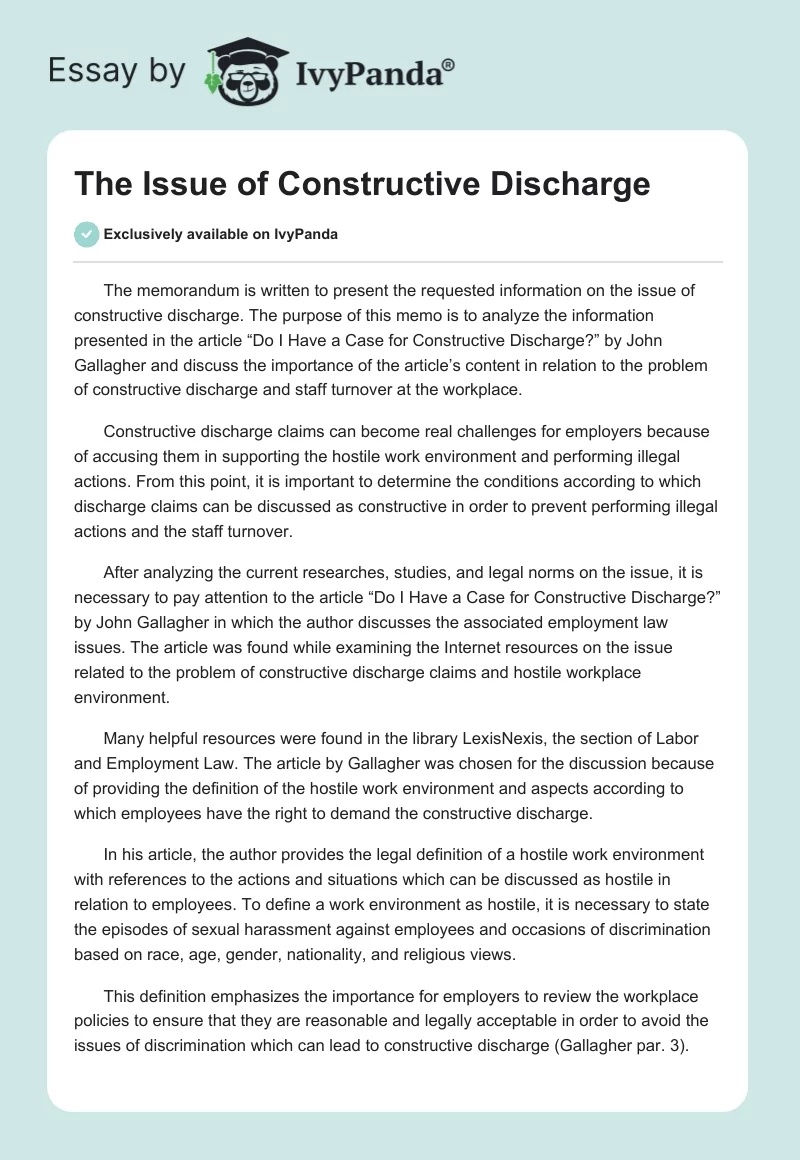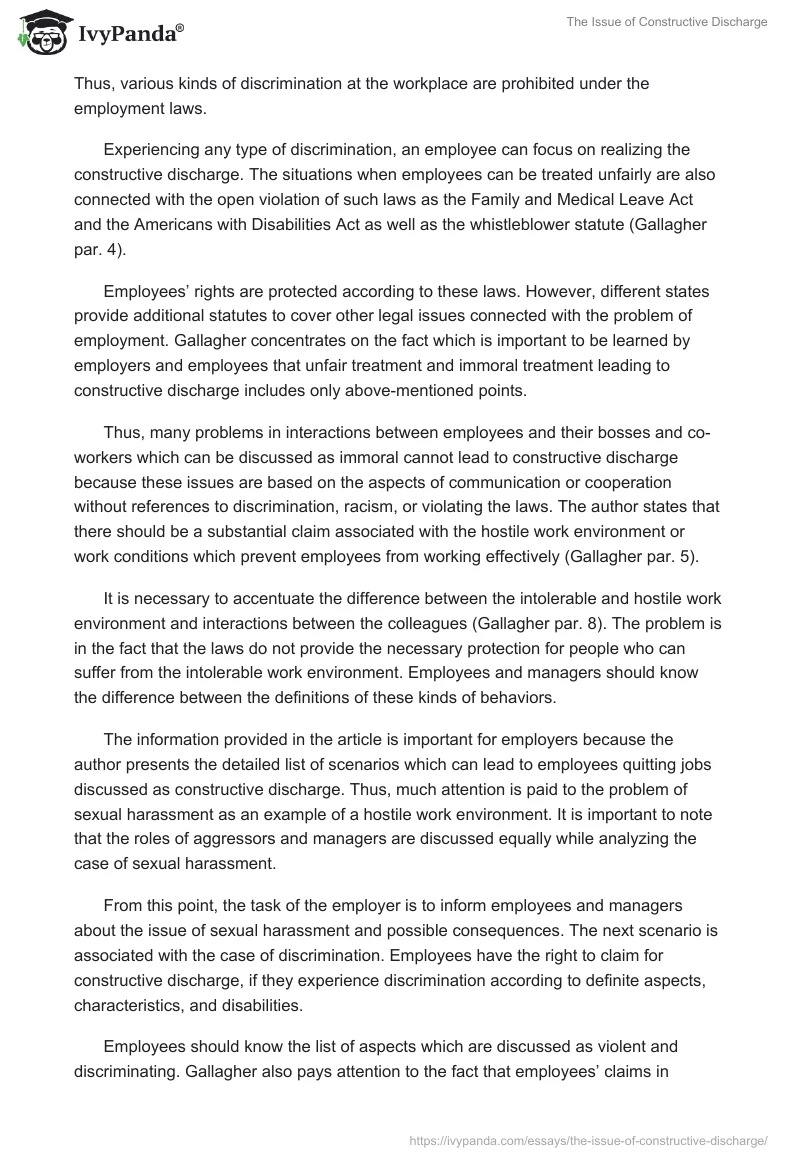The memorandum is written to present the requested information on the issue of constructive discharge. The purpose of this memo is to analyze the information presented in the article “Do I Have a Case for Constructive Discharge?” by John Gallagher and discuss the importance of the article’s content in relation to the problem of constructive discharge and staff turnover at the workplace.
Constructive discharge claims can become real challenges for employers because of accusing them in supporting the hostile work environment and performing illegal actions. From this point, it is important to determine the conditions according to which discharge claims can be discussed as constructive in order to prevent performing illegal actions and the staff turnover.
After analyzing the current researches, studies, and legal norms on the issue, it is necessary to pay attention to the article “Do I Have a Case for Constructive Discharge?” by John Gallagher in which the author discusses the associated employment law issues. The article was found while examining the Internet resources on the issue related to the problem of constructive discharge claims and hostile workplace environment.
Many helpful resources were found in the library LexisNexis, the section of Labor and Employment Law. The article by Gallagher was chosen for the discussion because of providing the definition of the hostile work environment and aspects according to which employees have the right to demand the constructive discharge.
In his article, the author provides the legal definition of a hostile work environment with references to the actions and situations which can be discussed as hostile in relation to employees. To define a work environment as hostile, it is necessary to state the episodes of sexual harassment against employees and occasions of discrimination based on race, age, gender, nationality, and religious views.
This definition emphasizes the importance for employers to review the workplace policies to ensure that they are reasonable and legally acceptable in order to avoid the issues of discrimination which can lead to constructive discharge (Gallagher par. 3). Thus, various kinds of discrimination at the workplace are prohibited under the employment laws.
Experiencing any type of discrimination, an employee can focus on realizing the constructive discharge. The situations when employees can be treated unfairly are also connected with the open violation of such laws as the Family and Medical Leave Act and the Americans with Disabilities Act as well as the whistleblower statute (Gallagher par. 4).
Employees’ rights are protected according to these laws. However, different states provide additional statutes to cover other legal issues connected with the problem of employment. Gallagher concentrates on the fact which is important to be learned by employers and employees that unfair treatment and immoral treatment leading to constructive discharge includes only above-mentioned points.
Thus, many problems in interactions between employees and their bosses and co-workers which can be discussed as immoral cannot lead to constructive discharge because these issues are based on the aspects of communication or cooperation without references to discrimination, racism, or violating the laws. The author states that there should be a substantial claim associated with the hostile work environment or work conditions which prevent employees from working effectively (Gallagher par. 5).
It is necessary to accentuate the difference between the intolerable and hostile work environment and interactions between the colleagues (Gallagher par. 8). The problem is in the fact that the laws do not provide the necessary protection for people who can suffer from the intolerable work environment. Employees and managers should know the difference between the definitions of these kinds of behaviors.
The information provided in the article is important for employers because the author presents the detailed list of scenarios which can lead to employees quitting jobs discussed as constructive discharge. Thus, much attention is paid to the problem of sexual harassment as an example of a hostile work environment. It is important to note that the roles of aggressors and managers are discussed equally while analyzing the case of sexual harassment.
From this point, the task of the employer is to inform employees and managers about the issue of sexual harassment and possible consequences. The next scenario is associated with the case of discrimination. Employees have the right to claim for constructive discharge, if they experience discrimination according to definite aspects, characteristics, and disabilities.
Employees should know the list of aspects which are discussed as violent and discriminating. Gallagher also pays attention to the fact that employees’ claims in relation to discrimination can lead to the managers’ negative reaction. Thus, the problem of an unlawful retaliation claim is also mentioned in the article (Gallagher par. 9).
The most problematic category of the laws violations associated with constructive discharge is the violation of the employment laws and acts. Thus, the employer and manager’s mistreatment of an employee based on ignorance of the FMLA or other laws and statutes can lead to the reasonable, constructive discharge because creating the working conditions which are inappropriate according to the laws (Gallagher par. 9).
Employees should pay attention to the consequences of their claims. If they notice the changes in the employer’s attitude which are closely associated with discrimination or changes in duties, employees have the right for constructive discharge because of employers’ illegal actions and attempts to prevent employees from receiving the benefits guaranteed according to the law.
One of the controversial aspects is a whistleblower complaint which is not met peacefully in many organizations, but which is discussed according to the legal norms (Gallagher par. 9). The provided list of scenarios should be carefully examined by employers, managers, and employees in order to predict and prevent the problematic situations and avoid the cases of constructive discharge.
The article by John Gallagher is helpful to examine the problem of constructive discharge in detail and develop the effective policy because the author puts emphasis on the fact that the standards for acceptance of constructive discharge claims are high, and they are closely associated with the legal standards required to prove the existence of a hostile work environment.
The information provided in the article can be successfully used to inform managers and employees about the necessary requirements for stating the fact of developing the hostile work environment. Moreover, it is important to inform employees that the information about any aspects discussed above as leading to constructive discharge should be shared with management in order to prevent the development of illegal issues.
Employers should take into account the information provided in the article because it is based on the current employment laws. Claiming for constructive discharge, employees should realize the conditions according to which their claims can be considered as reasonable because of the complex character of the issue.
Works Cited
Gallagher, John. Do I Have a Case for Constructive Discharge?. 2011. Web.


